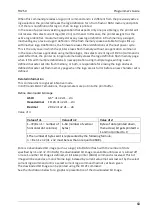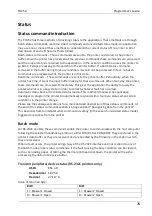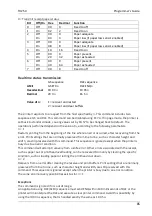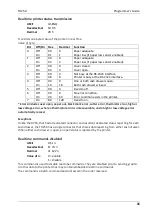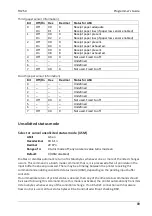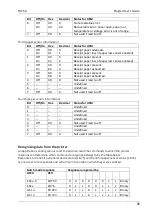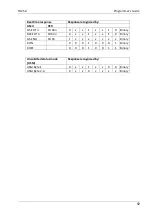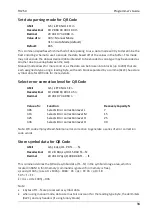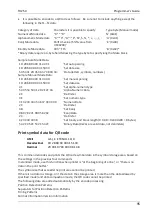
TH250
Programmer’s Guide
82
addition, there is no way to restart the printer after a paper jam or other error, when using batch
mode status commands.
The real time commands are implemented in two ways in order to overcome the limitations of
batch mode status commands. Both implementations offer the same functionality; which one you
choose depends on the current usage of your application.
Preferred implementation
For a new application the GS (1D) sequences are recommended to avoid possible
misinterpretation of a DLE (0x10) sequence as a clear printer (0x10 0, ASCII DLE NUL) command.
An application using these GS (1D) sequences, does not need to distinguish for the printer
between the new real time commands and the clear printer command. This implementation is
ideal for an existing application that already uses the clear printer command or for a new
application being developed.
Alternate implementation
The alternate implementation uses the DLE (0x10) sequences as implemented on other printers.
An application using these DLE (0x10) sequences and the original clear printer command (0x10)
must distinguish for the printer between the new real time commands and the clear printer
command by adding a NUL (0x00) to the clear printer command.
An application using these DLE (0x10) sequences must also send the second byte of the sequence
within 100 milliseconds of the first, to prevent the first byte being mistaken for a clear printer
command.
Rules for using real time commands
Three situations must be understood when using real time commands.
First, the printer executes the real time command within a few msec of detecting it in the input
buffer and will transmit status regardless of the condition of the DSR signal.
Second, the printer transmits status whenever it recognizes a real time status transmission
command sequence, even if that sequence happens to occur naturally within the data of another
command, such as graphics data.
In this case the sequence will also be handled correctly as the graphics data it is intended to be
when the graphics command is executed from the buffer.
Third, care must be taken not to insert a real time command into the data sequence of another
command that consists of two or more bytes.
In this case the printer will use the real time command sequence bytes instead of the other
command’s parameter bytes when finally executing that other command from the buffer; the
other command will NOT be executed correctly.
These three situations generally preclude use of standard DOS drivers for the serial communication
ports when using real time commands.
Moving data through the buffer
Applications should not let the buffer fill up with real time commands when the printer is busy at
the RS-232C interface. A busy condition at the RS-232C interface can be determined by bit 3 of the
response to 1D 05, or 1D 04 1, or 10 04 1. The reason for a particular busy condition can be
determined by other responses to 1D 04 n or 10 04 n.
Although the printer responds to real time commands when it is busy, it will place them into the
buffer behind any other data there, and flush them out in the order in which they were received.
Summary of Contents for TH250
Page 1: ...TH250 Thermal Printer Programmer s Guide January 2016 ...
Page 153: ...TH250 Programmer s Guide 148 Character code table Page 1 PC850 Multilingual Latin I ...
Page 154: ...TH250 Programmer s Guide 149 Character code table Page 2 PC852 Latin II ...
Page 155: ...TH250 Programmer s Guide 150 Character code table Page 3 PC860 Portuguese ...
Page 156: ...TH250 Programmer s Guide 151 Character code table Page 4 PC863 Canadian French ...
Page 157: ...TH250 Programmer s Guide 152 Character code table Page 5 PC865 Nordic ...
Page 158: ...TH250 Programmer s Guide 153 Character code table Page 6 PC858 Multilingual I Euro ...
Page 159: ...TH250 Programmer s Guide 154 Character code table Page 7 PC866 Russian ...
Page 160: ...TH250 Programmer s Guide 155 Character code table Page 8 WPC1252 Latin I ...
Page 161: ...TH250 Programmer s Guide 156 Character code table Page 9 PC862 Hebrew ...
Page 162: ...TH250 Programmer s Guide 157 Character code table Page 10 PC737 Greek ...
Page 163: ...TH250 Programmer s Guide 158 Character code table Page 11 PC874 Thai ...
Page 164: ...TH250 Programmer s Guide 159 Character code table Page 12 PC857 Turkish ...
Page 165: ...TH250 Programmer s Guide 160 Character code table Page 13 WPC1251 Cyrillic ...
Page 166: ...TH250 Programmer s Guide 161 Character code table Page 14 WPC1255 Hebrew ...
Page 167: ...TH250 Programmer s Guide 162 Character code table Page 15 KZ_1048 Kazakh ...
Page 168: ...TH250 Programmer s Guide 163 Character code table Page 16 WPC1254 Turkish ...
Page 169: ...TH250 Programmer s Guide 164 Character code table Page 17 WPC1250 Central Europe ...
Page 170: ...TH250 Programmer s Guide 165 Character code table Page 18 WPC28591 Latin 1 ...
Page 171: ...TH250 Programmer s Guide 166 Character code table Page 19 WPC28592 Latin 2 ...
Page 172: ...TH250 Programmer s Guide 167 Character code table Page 20 WPC28599 Turkish ...
Page 173: ...TH250 Programmer s Guide 168 Character code table Page 21 WPC28605 Latin 9 ...
Page 174: ...TH250 Programmer s Guide 169 Character code table Page 22 PC864 Arabic ...
Page 175: ...TH250 Programmer s Guide 170 Character code table Page 23 PC720 Arabic ...
Page 176: ...TH250 Programmer s Guide 171 Character code table Page 24 WPC1256 Arabic ...
Page 177: ...TH250 Programmer s Guide 172 Character code table Page 25 WPC28596 Arabic ...
Page 178: ...TH250 Programmer s Guide 173 Character code table Page 26 KATAKANA Asia ...
Page 179: ...TH250 Programmer s Guide 174 Character code table Page 27 PC775 Baltic ...
Page 180: ...TH250 Programmer s Guide 175 Character code table Page 28 WPC1257 Baltic ...
Page 181: ...TH250 Programmer s Guide 176 Character code table Page 29 WP28594 Baltic ...

